

| 2 Morpho-Phonology | 7a Using Affixes | 12 The Number System | |
| 3 Basic Morphology | 7b Using Affixes (continued) | The Lexicon | |
| 4 Case Morphology | 8 Adjuncts | Revised Ithkuil: Ilaksh |
In this chapter, we examine six additional morphological categories which apply to verbal formatives: Validation, Phase, Sanction, Aspect, Mood and Bias. Like the categories of Valence, Version, Conflation/Derivation, Format, Modality and Level in the previous chapter, these six categories are manifested within the morpho-phonological structure of a specialized adjunct, in this instance called an aspectual adjunct.
The structure of an aspectual adjunct is (CB-)VA-CX-(VS-(CB)) where VA and Vs are vocalic affixes indicating aspect, Cx is a consonantal infix indicating validation, phase and sanction, and CB is an optional consonantal prefix or suffix indicating Bias. Mood is indicated by the tone and stress pattern of the adjunct as a whole. VA represents either a single vowel, diphthong, or dissyllabic two-vowel combination (e.g., -ia-, -ua-); and Cx represents a single- or dual-consonant conjunct (e.g., -k-, -tt-, -šp-). Not all parts of this archetypical structure may manifest themselves in any given aspectual adjunct. For example, some adjuncts may show only aspect or mood, some show validation or phase only, or any combination of these categories. These variations are described below.
Having explained the structure of the aspectual adjunct, we now turn to an explanation of the six morphological categories it manifests.
| 6.1 VALIDATION |
Technically, Validation expresses the degree or type of evidence supporting a statement, a grammatical requirement of Ithkuil. Such categories are usually termed “evidentials” or “factives” in various non-Western languages which have them. However, Validation imparts more than simply the evidential verifiability of a statement; it also operates in conjunction with Mood (see Section 6.5 below) to indicate the precise factuality of a statement, i.e., to what extent it is likely or certain that the statement is, in fact, valid or real. We will see that Ithkuil moods generally indicate the factuality of a statement as being either certain or uncertain. Validation in turn “fine tunes” this distinction into levels of nuance, corresponding to various English phrases which convey the specific validity of a statement, e.g., “must be so, likely that, unlikely, perhaps, supposedly, presumably, apparently” etc. The nine validations are CONFIRMATIVE, REPORTIVE, INTUITIVE, INFERENTIAL, PRESUMPTIVE, CONJECTURAL, TENTATIVE, PUTATIVE and HORTATIVE. As explained above, they are shown in conjunction with the categories of Phase and Sanction (see Secs. 6.2 and 6.3 below) by means of the Cx consonantal affix to an aspectual adjunct. The values for these infixes are shown in the tables below. The specific usage of each validation is explained following the tables.
Tables
18 (a –
i): Cx Affixes By Validation, Phase and Sanction
Table 18(a): Cx Affixes for
the Confirmative Validation
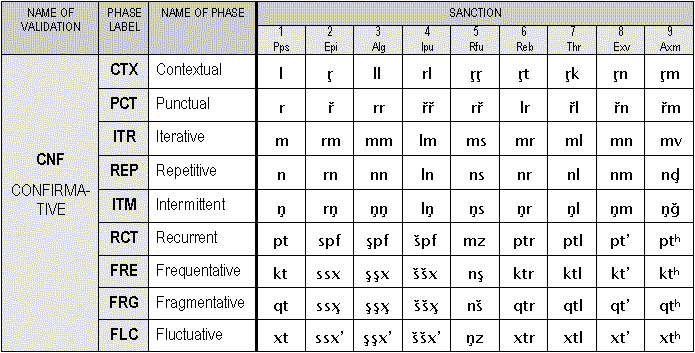
Table 18(b): Cx Affixes for the Reportive Validation
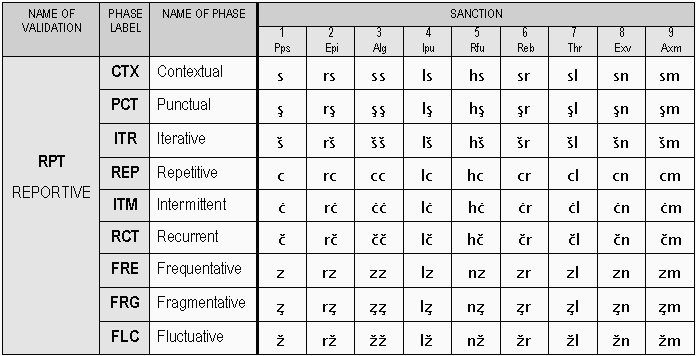
Table 18(c): Cx Affixes for the Intuitive Validation
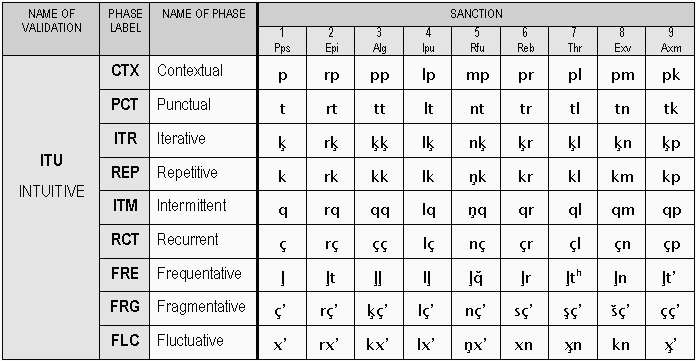
Table 18(d): Cx Affixes for the Inferential Validation

Table 18(e): Cx Affixes for the Presumptive Validation

Table 18(f): Cx Affixes for the Conjectural Validation
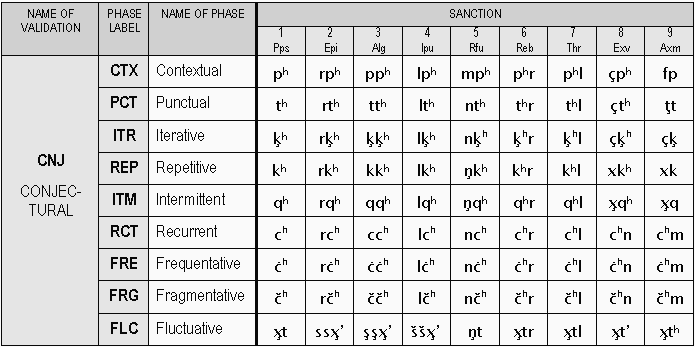
Table 18(g): Cx Affixes for the Tentative Validation

Table 18(h): Cx Affixes for the Putative Validation

Table 18(i): Cx Affixes for the Hortative Validation

The nine validations are explained as follows:
| 6.1.1 | CNF |
The Confirmative |
The CONFIRMATIVE indicates that a statement
is based on facts actually perceived by and/or personally known to the speaker.
It can be considered the “default” validation, in that it can be
unmarked (i.e., the aspectual adjunct can be deleted) if the other categories
shown by the adjunct are likewise in their default modes and there is no aspect
being conveyed.
| 6.1.2 | RPT |
The Reportive |
The REPORTIVE validation indicates that
the statement, while not personally known or perceived by the speaker, is assumed
true based on evidence considered trustworthy by the speaker, such as direct
testimony of a trusted party or knowledgeable source based on that party’s
or source’s personal knowledge or observation. If necessary, this degree
of factivity can be translated into English by the terms ‘most likely’
or ‘probably.’
| 6.1.3 | ITU |
The Intuitive |
The INTUITIVE validation indicates that
the statement is based on the speakers own intuition, instinct or “gut”
feeling. This can be translated by English phrases such as ‘I feel that…’
or ‘I’ve got a feeling that….’
| 6.1.4 | INF |
The Inferential |
The INFERENTIAL validation indicates
that the statement is essentially an inference by the speaker based on circumstantial
evidence only. This can be conveyed in translation by phrases such as ‘(it)
must (be that)…,’ or ‘must have’ as in the sentences
I must be dreaming or It must have rained last night.
| 6.1.5 | PSM |
The Presumptive |
The PRESUMPTIVE validation indicates
that the statement is hearsay whose validity is assumed true based on the absence
of a motive for deception on the part of the speaker, and the fact that the
statement is potentially verifiable. If necessary, this degree of factivity
can be translated by the English phrases ‘presumably (so) or ‘apparently
(so).’
| 6.1.6 | CNJ |
The Conjectural |
The CONJECTURAL validation indicates
that the statement is hearsay whose validity is assumed true based on the absence
of a motive for deception on the part of the speaker, however its verifiability
is either unlikely or unknown. Perhaps most easily translated into English simply
by ‘may’ or ‘might,’ or more exactly by ‘allegedly’
or ‘purportedly.’
| 6.1.7 | TEN |
The Tentative |
The TENTATIVE validation indicates that
the statement is hearsay whose validity is assumed false due to untrustworthiness
or unreliability of the source, or a motive for deception on the part of the
speaker; however, the statement is potentially verifiable. Can be approximately
translated by English ‘supposedly.’
| 6.1.8 | PUT |
The Putative |
The PUTATIVE validation indicates that
the statement is hearsay whose validity is assumed false due to untrustworthiness
or unreliability of the source or a motive for deception on the part of the
speaker, and verifiability of the statement is either unlikely or unknown. Can
be approximately translated by English ‘must not (have)…,’
‘must not be…,’ or ‘not likely to….’ Thus
the sentence overtly structured as He caught the bus in time but marked
for the PUTATIVE would actually translate as He must
not have caught the bus in time.
| 6.1.9 | HOR |
The Hortative |
The HORTATIVE validation indicates that the validity of the statement is assumed false but that the speaker wishes it to be true. It corresponds to various exhortations such as ‘if only…,’ ‘I wish that…’ or ‘Were that….’
Phase refers to variances in the temporal pattern of how an
act, condition or event occurs, e.g., in a momentary, lasting, or repetitive
manner (or lack thereof). This is especially useful in describing phenomena
that occur in sudden bursts of short duration, e.g., flashing, sputtering, blinking,
alternating, etc. Phase functions closely with the morphological category of
Extension, previously described in Sec.
3.4, to specify the durational nature, starting and ending, and operative
pattern of a state, action or event. The nine phases are the CONTEXTUAL,
PUNCTUAL, ITERATIVE, REPETITIVE, INTERMITTENT, RECURRENT, FREQUENTATIVE, FRAGMENTATIVE,
and FLUCTUATIVE. They are marked by one of nine patterns
of the Cx affix to an aspectual adjunct, depending on the validation and sanction
of the verb as previously described in Section 6.1 and
shown in Tables 18(a) through 18(i). The nine phases
are explained in the following sections.
| 6.2.1 | CTX |
The Contextual |
The CONTEXTUAL is the default phase,
describing a single act, condition, or event as a relatively brief (but not
instantaneous), single holistic occurrence considered once, where the actual
duration of the occurrence is not relevant in the particular context. It can
be visually represented along a progressive timeline by a short dash, e.g.,
—
| 6.2.2 | PUN |
The Punctual |
The PUNCTUAL describes an act, condition,
or event which is point-like, momentary or instantaneous in nature, such as
an explosion, a flash of lightning, a blow, a single handclap, a collision between
two objects, a stab of pain, a single cough, the clicking of a lock, etc. It
can be visually represented along a timeline by a single point, e.g., •
| 6.2.3 | ITR |
The Iterative |
The ITERATIVE refers to a momentary or instantaneous event, like the PUNCTUAL above, which repeats itself in a rapid, on/off, staccato manner, like a machine gun burst, strobe light burst, an alarm bell ringing, or the quick unconscious tapping of a finger, the whole comprising a single CONTEXTUAL event.
Visual representation: • • • •
| 6.2.4 | REP |
The Repetitive |
The REPETITIVE refers to a relatively
brief event of indeterminate or vague duration (i.e., as with the CONTEXTUAL
phase above), but repeated in an on/off staccato manner, like a car horn being
honked repeatedly in a fast steady rhythm, or an automatic machine press. Visual
representation: — —
— —
| 6.2.5 | ITM |
The Intermittent |
The INTERMITTENT is similar to the ITERATIVE above, identifying a repetitive occurrence of a PUNCTUAL event, however, unlike the ITERATIVE, the duration of time between repetitions is relatively long and contextually relevant. It would be used in describing the downbeat pattern of a pop song, the ongoing snapping of fingers to music, the steady one-drop-at-a-time dripping of a faucet, etc.
Visual representation: —
• — • —
• — •
| 6.2.6 | RCT |
The Recurrent |
The RECURRENT is to the REPETITIVE as the INTERMITTENT is to the ITERATIVE. It indicates a slow repetition of a CONTEXTUAL event, where the duration between occurrences is relatively long and contextually relevant. Exemplified by the sounding of a foghorn, or the ongoing hooting of an owl.
Visual representation: ——
———
———
———
—
| 6.2.7 | FRE |
The Frequentative |
The FREQUENTATIVE indicates an iterative occurrence (a single set of punctual repetitions) which in turn repeats at intervals, the whole considered as a single CONTEXTUAL event. Examples would be the repetitive sets of hammerings of a woodpecker or the repeated short bursts of a jackhammer.
Visual representation: ——•
• •—
• •
•—
• •
•—
• •
•
| 6.2.8 | FRG |
The Fragmentative |
The FRAGMENTATIVE indicates a random pattern of punctual occurrences, the whole considered as a single CONTEXTUAL event.
Visual representation: ——•
•—
• •
• ——•
• —•
• •
• •——
• —•
•
| 6.2.9 | FLC |
The Fluctuative |
The FLUCTUATIVE indicates a random pattern of both punctual and longer occurrences. An example would be the “sputtering” of a lighted fuse, the random patterns of tongues of flames, the chirping of birds in the wild, etc.
Visual representation:—— • • —— • — • •— ——• • — • • • —• •— —— • — • •
The morphological category of Sanction indicates the discourse-related purpose of an utterance in relation to what sort of truthfulness the listener should ascribe to it. In everyday terms, this corresponds to whether the utterance is a neutral proposition or assertion, an allegation, a rebuttable presumption, a counter-argument, a refutation of an allegation, a rebuttal, etc.
There are nine sanctions: the PROPOSITIONAL,
EPISTEMIC, ALLEGATIVE, IMPUTATIVE, REFUTATIVE, REBUTTATIVE, THEORETICAL, EXPATIATIVE,
and AXIOMATIC. Sanction is shown by the mutational grade
of the Cx affix to an aspectual adjunct, as shown in Table
18 in Sec. 6.1 above, the specific affix value being dependent on the validation
and phase of the verb. Each sanction is explained in the sections below.
| 6.3.1 | PPS |
The Propositional |
The PROPOSITIONAL sanction is either
unmarked (where there is no aspectual adjunct), or marked by Grade 1 mutation
of the Cx affix. It is the default sanction, indicating the utterance represents
a neutral proposition or assertion of ontologically objective fact, i.e., a
statement of fact irrespective of third-party opinion, belief, or interpretation.
Example of such statements would be That is a mountain, or I’m
hungry.
| 6.3.2 | EPI |
The Epistemic |
The EPISTEMIC sanction is marked by Grade
2 mutation of the Cx affix. It identifies an utterance as being a statement
of shared knowledge or conventionalized fact whose ontology is human convention
(i.e., agreed-upon knowledge) as opposed to objective fact irrespective of human
knowledge. An example would be That mountain is Mount Fuji or The
U.N. tries to relieve hunger in the Third World.
| 6.3.3 | ALG |
The Allegative |
The ALLEGATIVE identifies an utterance
as an ontologically subjective assertion or allegation, i.e., a proposition
expressing one’s opinion, belief, or interpretation, open to challenge
or refutation. Examples would be That mountain is beautiful or No
one in the United States goes hungry.
| 6.3.4 | IPU |
The Imputative |
The IMPUTATIVE identifies an utterance
as a rebuttable presumption, i.e., an assertion, whether ontologically objective
or by convention, that is to be assumed true unless and until rebutted by a
sufficient counter-argument or other evidence. Examples would be He knows
how to drive [e.g., because he owns a car] or She can’t be hungry
now [e.g., because I saw her come out of the restaurant].
| 6.3.5 | RFU |
The Refutative |
The REFUTATIVE identifies an utterance
as a counter-allegation, refutation, or rebuttal of a previous assertion, allegation
or presumption, where the counter-allegation, refutation, or rebuttal is epistemic
in nature, i.e., based on shared human knowledge as opposed to ontologically
objective fact.
| 6.3.6 | REB |
The Rebuttative |
The REBUTTATIVE identifies an utterance
as a counter-allegation, refutation, or rebuttal of a previous assertion, allegation
or presumption, where the counter-allegation, refutation, or rebuttal is based
on ontologically objective fact, irrespective of subjective opinion, belief,
or interpretation.
| 6.3.7 | THR |
The Theoretical |
The THEORETICAL identifies an utterance
as a testable hypothesis or potentially verifiable theory.
| 6.3.8 | EXV |
The Expatiative |
The EXPATIATIVE identifies an utterance
as a hypothesis or theory that is not necessarily provable or verifiable.
| 6.3.9 | AXM |
The Axiomatic |
The AXIOMATIC identifies an utterance as a conclusive presumption, i.e., a statement of ontologically objective, pan-experiential fact not open to rational argument or refutation. Examples would be Gravity is ubiquitous, or Hunger is caused by not consuming enough food.
Aspect provides detailed and specific temporal information about the verb, not in relation to the speaker’s present moment of utterance (as with Perspective in Sec. 3.3), but rather in relation to the contextual “present” of the act, condition, or event being spoken about. There are 32 aspects, each shown by a vocalic prefix to an aspectual adjunct. A second aspect may be shown by a vocalic suffix. For the most part, they translate various common adverbial phrases used in English.
As explained above in Sec. 6.0, each aspect is represented by a single vocalic form, appearing as a prefix in an aspectual adjunct. A second aspect may be associated with the verb, in which case it appears as a vocalic suffix to the adjunct. The form of the adjunct is Vp-Cx-(Vs), where Vp is the prefixed form of the first aspect, Cx is the consonantal validation-phase-sanction infix, and Vs, if present, is the suffixed form of the second aspect.
Each prefix has seven alternate forms for a total of eight
forms whose use is explained in Sec. 6.4.2 below. The first form of the prefix
is the default form. The suffix form of each aspect has but one form. The values
of these prefixes and suffixes is shown in Table 19 below.
Table 19: Aspectual Prefixes (Vp) and Suffixes (Vs)

The eight forms of each aspect prefix are used as an alternate
way of indicating Format (See Sec.
5.4.2) in the absence of a conflation (or valence) adjunct. Because they
also show Valence, Version and Modality, it is common to use conflation adjuncts
with an Ithkuil verb; however, where there is no modality, the verb displays
conflation (see Sec. 5.4.1)
but no derivation, and the version and valence have default values, the conflation
adjunct can be eliminated and the verb’s format can be indicated by forms
1 through 8 of the aspect prefix to the verb’s aspectual adjunct. Thus,
in the sentence ![]() ,
the conflation adjunct
,
the conflation adjunct ![]() indicating INSTRUMENTATIVE format for the ACTIVE
conflation shown by the main verb, can instead be shown by changing the prefix
â-
on the aspectual adjunct to wâ-
and eliminating the conflation adjunct, thus:
indicating INSTRUMENTATIVE format for the ACTIVE
conflation shown by the main verb, can instead be shown by changing the prefix
â-
on the aspectual adjunct to wâ-
and eliminating the conflation adjunct, thus:
![]()
Wâloi uatumul.
![]()
‘The motion being caused by means of an asteroid is indeed recurring’
OR
‘What’s indeed happening is a recurrence of motion using an
asteroid.’
The thirty-two aspectual categories are explained below.
| 6.4.3.1 | RTR |
RETROSPECTIVE |
| 6.4.3.2 | PRS |
PROSPECTIVE |
| 6.4.3.3 | HAB |
HABITUAL |
| 6.4.3.4 | PRG |
PROGRESSIVE |
| 6.4.3.5 | IMM |
IMMINENT |
| 6.4.3.6 | PCS |
PRECESSIVE |
| 6.4.3.7 | REG |
REGULATIVE |
| 6.4.3.8 | EPR |
EXPERIENTIAL |
| 6.4.3.9 | RSM |
RESUMPTIVE |
| 6.4.3.10 | CSS |
CESSATIVE |
| 6.4.3.11 | RCS |
RECESSATIVE |
| 6.4.3.12 | PAU |
PAUSAL |
| 6.4.3.13 | RGR |
REGRESSIVE |
| 6.4.3.14 | PCL |
PRECLUSIVE |
| 6.4.3.15 | CNT |
CONTINUATIVE |
| 6.4.3.16 | ICS |
INCESSATIVE |
| 6.4.3.17 | PMP |
PREEMPTIVE |
| 6.4.3.18 | CLM |
CLIMACTIC |
| 6.4.3.19 | PTC |
PROTRACTIVE |
| 6.4.3.20 | TMP |
TEMPORARY |
| 6.4.3.21 | MTV |
MOTIVE |
| 6.4.3.22 | CSQ |
CONSEQUENTIAL |
| 6.4.3.23 | SQN |
SEQUENTIAL |
| 6.4.3.24 | EPD |
EXPEDITIVE |
| 6.4.3.25 | DSC |
DISCLUSIVE |
| 6.4.3.26 | CCL |
CONCLUSIVE |
| 6.4.3.27 | CUL |
CULMINATIVE |
| 6.4.3.28 | IMD |
INTERMEDIATIVE |
| 6.4.3.29 | TRD |
TARDATIVE |
| 6.4.3.30 | TNS |
TRANSITIONAL |
| 6.4.3.31 | ITC |
INTERCOMMUTATIVE |
| 6.4.3.32 | CSM | CONSUMPTIVE |
Note that, while any aspectual adjunct can show two different aspects, several aspect categories above operate as complements to each other. For example, the PROSPECTIVE aspect complements the RETROSPECTIVE aspect, both being essentially opposites. Such complementary aspects normally don’t appear in the same adjunct together. If they do appear in the same adjunct, they are interpreted as not applying to the same verb, i.e., the first aspect (shown by the prefix) applies to the adjacent verb, while the second aspect (shown by the suffix) applies to the next verb in the sentence. Such combinations of complementary aspects within a single adjunct can be considered an optional “shortcut” to utilizing a separate aspectual adjunct with the second verb.
All of the aspectual prefixes shown in Table
19 above can in turn take an initial prefix y-
(or yï-
before a w-)
to show that the associated verbal formative has semantic focus (as described
in Sec. 3.5), i.e.,
it is an alternate to the usual -w-
infix to the formative previously described in Sec. 3.5. Examples: êstiu
![]() yêstiu,
iwuil
yêstiu,
iwuil ![]() yiwuil,
wïttu
yiwuil,
wïttu ![]() yïwïttu.
yïwïttu.
This y-
(or yï-)
prefix can in turn be augmented to yï’
(spelled y’
before a vowel but still pronounced yï’)
to indicate that the semantic focus instead applies to the aspectual meaning
indicated by the aspectual prefix. Examples: êstiu
![]() y’êstiu,
iwuil
y’êstiu,
iwuil ![]() y’iwuil, wïttu
y’iwuil, wïttu
![]() yï’wïttu.
yï’wïttu.
Most languages have a morphological category for verbs known as “mood,” serving to indicate specific attitudes or perspectives on the act, condition, or event, or the degree of factuality involved. Example moods common to Western languages include the indicative (factual utterances), subjunctive (showing doubt or probability, expressed by ‘may/might’ in English), imperative (indicating commands, e.g., Go now!, Sing it for us! ), conditional (expressing hypotheticals, e.g., She would travel if she could), optative (indicating wishes, hopes, expectations, e.g., I wish he’d go, I expect him to be here), and hortative (indicating exhortations, e.g., May he live 100 years! Let them see for themselves!).
We have already seen in Section 5.1 above that in Ithkuil the functions of certain moods in Western languages correspond not to Mood, but to the grammatical category of Illocution, specifically where Western moods function to describe types of speech acts. In Ithkuil, moods simply convey a two-fold distinction as to whether the factuality of an utterance is certain or uncertain, combined with a four-way distinction as to whether the factuality of an explicit or implicit assumption underlying the utterance (i.e., a presupposition) is true, false, unknown, or a determinant of the factuality of the utterance. This twofold by fourfold matrix renders eight moods in Ithkuil, shown by stress and tone of the aspectual adjunct accompanying the verb.
The eight moods are FACTUAL, SUBJUNCTIVE, ASSUMPTIVE,
SPECULATIVE, COUNTERFACTIVE, HYPOTHETICAL, IMPLICATIVE, and ASCRIPTIVE.
These are described in the sections below.
| 6.5.1 | FAC |
The Factual |
The FACTUAL mood is shown by penultimate stress and falling tone on the aspectual adjunct. This mood signifies that the factuality of the speaker’s statement is certain and that there either is no underlying presupposition to the statement, or if there is, its factuality is also certain or has no bearing on the factuality of the statement. As described above, the actual interpretation (and translation) of any statement in the FACTUAL mood is subject to whatever specific nuances of attitude, perspective, and evidence are imparted by the particular bias and validation associated with the verb. Examples:
His kids are ill. [i.e., it is known he has kids and it is known they are ill]
We’re taking a walk later on. [i.e., it is our
intention and we have the opportunity to do so]
| 6.5.2 | SUB |
The Subjunctive |
The SUBJUNCTIVE mood is shown by ultimate stress and falling tone on the aspectual adjunct. This mood indicates that the factuality of an explicit or implicit presupposition underlying the statement is certain, but the factuality of the speaker’s statement itself is questionable or uncertain, the specific nuance of factuality intended being subject to the particular Bias and Validation associated with the verb. Corresponds roughly with English ‘may,’ ‘maybe’ or ‘might,’ with the added distinction that an explicit or implicit (i.e., underlying) presupposition is true. Examples:
Maybe his kids are ill. [i.e., it is known that he has kids but it is not known whether they are ill]
We may take a walk later on. [i.e., it is known that
the opportunity to do so will arise, but it is uncertain whether we will choose
to]
| 6.5.3 | ASM |
The Assumptive |
Shown by penultimate stress and high tone on the aspectual adjunct. This mood functions identically to the FACTUAL except that the factuality of an underlying presupposition is unknown. It therefore conveys an act, state, or event whose factuality is dependent on whether something else is factual, thus corresponding to certain usages of English ‘maybe’ and ‘will’ (where ‘will’ primarily conveys possibility, not future tense). As with all moods, the specific translation is subject to the particular Bias and Validation associated with the verb. Examples:
His kids’ll be ill OR If he has kids, they are ill. [i.e., it is unknown whether he has kids, but if he does, they are certainly ill.]
We’ll take a walk later on [i.e., if we can]
OR We intend to take a walk.
[i.e., but we don’t know if we’ll be able to]
| 6.5.4 | SPE |
The Speculative |
Shown by ultimate stress and high tone on the aspectual adjunct. This mood indicates that the factuality of both the presupposition and the statement itself are unknown. Its translation into English is dependent on the specific context, sometimes corresponding to ‘may,’ ‘maybe’ or ‘might,’ and at other times corresponding to the auxiliary ‘would.’ Compare the examples below to those above:
Maybe his kids are ill [i.e., it is unknown if he has kids but if he does, they may be ill].
We may take a walk later on [i.e., it is unknown whether
we will have the opportunity to do so, and even if we do, it is uncertain whether
we will choose to].
| 6.5.5 | COU |
The Counterfactive |
Shown by penultimate stress and broken tone on the aspectual adjunct. This mood indicates that the factuality of the underlying presupposition is false or unreal but that the factuality of the statement would otherwise be true. It thus corresponds to the English construction of auxiliary ‘would’ or ‘would have’ in its use to show counterfactuality (i.e., what would have been if a false presupposition had been true). Again, the specific translation is subject to the particular Bias and Validation associated with the verb. Compare the examples below to those above.
His kids would be (would have been) ill [i.e., if he had kids they would be ill, but he doesn’t].
We would take (would have taken) a walk later on [i.e.,
it is our intention but we won’t have the opportunity].
| 6.5.6 | HYP |
The Hypothetical |
Shown by ultimate stress and broken tone on the aspectual adjunct. This mood indicates that the factuality of the underlying presupposition is false or unreal and that the factuality of the statement itself is uncertain. It thus corresponds to the English construction of auxiliary ‘might have’ in its use to show possible counterfactuality (i.e., what might have been if a false presupposition had been true). Again, the specific translation is subject to the particular Bias and Validation associated with the verb. Compare the examples below to those above.
His kids might’ve been ill [if he had kids, but he doesn’t, so we’ll never know].
We might’ve taken a walk later on [i.e., but
we won’t have the opportunity, so the decision whether to do so is moot].
| 6.5.7 | IPL |
The Implicative |
Shown by penultimate stress and rising tone on the aspectual adjunct. This mood indicates that the factuality of the underlying presupposition determines the factuality of the statement and that the relationship between the two need not necessarily be a direct cause-and-effect, but merely an indirect chain of events from which the speaker infers the statement from the underlying presupposition. In grammatical analysis, this is referred to as an “epistemic conditional.” Examples are shown below.
His kids are (must be) ill [i.e., as implied by some other fact such as his staying home from work].
If she wears a blue dress, we’ll be taking a walk
later on OR She’s wearing
a blue dress, so that means we’ll be taking a walk later on [i.e.,
the dress implies something has happened that we’ll make the walk a certainty].
| 6.5.8 | ASC |
The Ascriptive |
Shown by ultimate stress and rising tone on the aspectual adjunct. The ASCRIPTIVE mood functions identically to the IMPLICATIVE immediately above, except that the factuality of the inference derived from the underlying presupposition is uncertain. Examples:
His kids may be ill [i.e., as implied by some other fact such as his staying home from work].
If she wears a blue dress, we might be taking a walk later on OR She’s wearing a blue dress, so that means we might be taking a walk later on [i.e., the dress implies something has happened that we’ll make the walk a possibility].
Bias expresses the general, overall subjective/emotional attitude or perspective in which the speaker regards the action. There are 24 basic bias categories, each of which has an additional “intensive” form which often warrants a change in English translation. Bias operates closely with Validation (previously discussed in Sec. 6.1), often triggering a translation change as well.
Bias is shown in any one of four ways:
These prefix, suffix, and infix forms are shown in Table 20 below. The forms to the right of the arrow are the “intensive” forms described above. The 24 biases are explained following the table.
Table 20: Morpho-Phonological
Markers for Bias
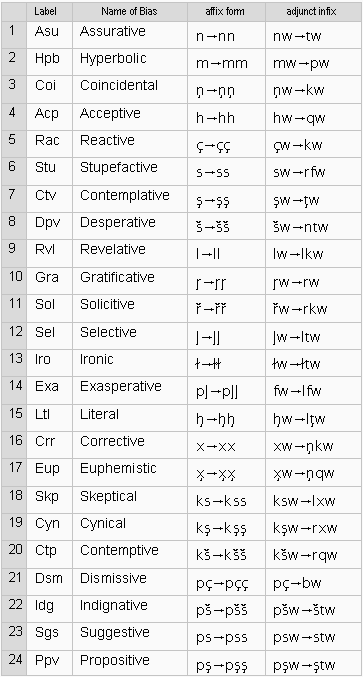
| 6.6.1.1 | ASU |
ASSURATIVE |
| 6.6.1.2 | HPB |
HYPERBOLIC |
| 6.6.1.3 | COI |
COINCIDENTAL |
| 6.6.1.4 | ACP |
ACCEPTIVE |
| 6.6.1.5 | RAC |
REACTIVE |
| 6.6.1.6 | STU |
STUPEFACTIVE |
| 6.6.1.7 | CTV |
CONTEMPLATIVE |
| 6.6.1.8 | DPV |
DESPERATIVE |
| 6.6.1.9 | RVL |
REVELATIVE |
| 6.6.1.10 | GRA |
GRATIFICATIVE |
| 6.6.1.11 | SOL |
SOLICITIVE |
| 6.6.1.12 | SEL |
SELECTIVE |
| 6.6.1.13 | IRO |
IRONIC |
| 6.6.1.14 | EXA |
EXASPERATIVE |
| 6.6.1.15 | LTL |
LITERAL |
| 6.6.1.16 | CRR |
CORRECTIVE |
| 6.6.1.17 | EUP |
EUPHEMISTIC |
| 6.6.1.18 | SKP |
SKEPTICAL |
| 6.6.1.19 | CYN |
CYNICAL |
| 6.6.1.20 | CTP |
CONTEMPTIVE |
| 6.6.1.21 | DSM |
DISMISSIVE |
| 6.6.1.22 | IDG |
INDIGNATIVE |
| 6.6.1.23 | SGS |
SUGGESTIVE |
| 6.6.1.24 | PPV |
PROPOSITIVE |
Proceed to Chapter 7: Using Affixes >>
| 2 Morpho-Phonology | 7a Using Affixes | 12 The Number System | |
| 3 Basic Morphology | 7b Using Affixes (continued) | The Lexicon | |
| 4 Case Morphology | 8 Adjuncts | Revised Ithkuil: Ilaksh |
©2004-2009 by John Quijada. You may copy or excerpt any portion of the contents of this website provided you give full attribution to the author and this website.